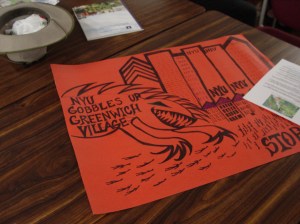N.Y.U.’s Plans: An Assessment (And! Villager Compares School to Hitler)
 On Monday evening in the West Village, one of the over 200 local residents at a public hearing on N.Y.U.’s expansion asked anyone who supported the school’s 2031 plan to raise his or her hand.
On Monday evening in the West Village, one of the over 200 local residents at a public hearing on N.Y.U.’s expansion asked anyone who supported the school’s 2031 plan to raise his or her hand.
No one moved an inch.
There are undoubtedly some supporters of the ambitious proposal to add 6 million square feet of new space throughout the city over the next 20 years. But they were either in hiding or cowed into silence at Community Board 2’s hearing, which focused on the school’s desire for a new tower south of Washington Square Park, on the landmarked I.M. Pei-designed Silver Towers site.
>> SEE A SLIDESHOW OF THE PRESENTATION
The hearing quickly became an hour of verbal attacks against the school. Resident after resident bombarded N.Y.U. vice president Alicia Hurley and representatives of Grimshaw Architects, who designed the new tower, channeling preservationist icon Jane Jacobs and, in a particularly dramatic moment, portraying N.Y.U. president John Sexton as a Shakespearean King John, presiding over his feudal Greenwich Village subjects, crown and all. Others compared N.Y.U.’s expansion plan to BP’s chemical oil spill; a giant spiked reptile devouring puny humans; and, um, Hitler marching into Poland.
“I was a little stunned by N.Y.U.’s statement that this new proposal and this new design shows respect for the environment of Greenwich Village; I think it’s a little like BP saying they show respect for the environment,” said Andrew Berman, the oft-quoted director of the Greenwich Village Society for Historic Preservation. “The most important thing here is N.Y.U. does have viable alternatives that they are refusing to consider.”
“It has two façades, both of them ugly,” said Mark Fiedler, comparing the tower to 22 Federal Plaza downtown.
Not one of the dozens of people who spoke supported the project.
It wasn’t all name-calling. Many residents brought up pragmatic concerns over the new tower, which is proposed at 270,000 square feet and 38 stories, slightly taller than the existing trio of I.M. Pei-designed buildings. N.Y.U. wants to run a hotel for visiting scholars and families of faculty and students, as well as the general public, and locals are concerned that it would cause more traffic congestion in an already tight space. The school wants to create more green, open space, but residents said that current facilities, such as the dog run and playground, were already falling into disrepair, and new open space would not address the needs of the community. The tower would also block sightlines on Greene Street and Wooster Street, argued residents.
“As they gobble us up, I would like to say that the idea of planting a playground at my family’s window is absolutely unacceptable,” said a member of the Washington Place Block Association. She said that N.Y.U.’s faculty and family would use the new facilities, not local residents, many of whom are elderly.
BUT WHILE LOCALS would like to portray the battle as one between a monster developer and a band of underdogs, they are essentially waging a campaign of absolute negativity. And this negativity sometimes spills over into simple rudeness—in multiple instances Community Board 2’s David Gruber, chair of the Arts and Institution Committee, had to shush residents who called out and hissed while Ms. Hurley and her colleagues spoke. No one disputes that residents are rightfully passionate about Greenwich Village, but their methods may alienate the more moderate among them.
Really, the issue here is beyond N.Y.U. and Greenwich Village. It is a scenario that has played out again and again: A big developer wishes to fundamentally alter the landscape and skyline of a part of New York; local residents oppose the move, but instead of compromising, they seek to completely eliminate any changes.
However, the reality is, N.Y.U. wants to build at the Silver Towers site because the school already owns the land, having purchased segments of it over the last few decades, according to both Ms. Hurley and university spokesman John Beckman. The university has a $2.2 billion endowment, far less than the Ivy League schools it aspires to compete with, and buying new plots to develop is an expensive proposition, even in the relatively bargain-rate Financial District. Having said that, Mr. Beckman confirmed on Monday evening that the school is still open to the idea of looking downtown for some space, but is looking to move away from leases, which it used to have for dorms on Water and Cliff streets until 2008.
“We are planning on talking with the Lower Manhattan Development Corporation and Port Authority about opportunities downtown,” said Mr. Beckman after the community board meeting.
The fourth tower on the Silver Towers site is far from approved—the proposal must first go through the Landmarks Preservation Commission, because the I.M. Pei site is landmarked, and then through City Planning in a land-use review process. Judging from the passionate opposition, N.Y.U. has its work cut out, but it also has the option of building at the current Morton Williams grocery site, on the northwest corner of the superblock. While this rather abyss-like building is seen by some as a threat if the other tower isn’t successful, it should be noted that N.Y.U. is electing to pursue the additional, likely painful, process of seeking Landmarks approval, in order to move the tower east. The architects argue that this move is a desire to build the tower as a more contextual building that preserves I.M. Pei’s “pinwheel” design, which allows each of the current three buildings to have site lines from and toward the buildings’ façades.
N.Y.U.’S IDEALISTIC REASONING should, of course, be taken with a grain of salt. While nominally a nonprofit, the school is one of the biggest landowners in the entire city and its desire to grow is motivated in no small part by the prestige and economic incentives of more facilities and, likely, more endowment. But it cannot be said that the school is seeking to simply build a tower as quickly as possible—the conception process has already taken years, and it will likely be decades before this site is developed. And while opponents might snarl that the school is simply trying to manipulate public perceptions, there have been parts of the process that have been long thought out.
As much as Village residents are loathe to admit, N.Y.U. is an essential part of New York City’s identity. The school’s ambitious transformation in the last few decades from a poor commuter school into one of the world’s more prominent research institutions has mirrored the same gung-ho development of the entire city. In many ways, N.Y.U. symbolizes much of what is great and horrible about New York. Development has created jobs and some of the most impressive feats of architecture and engineering in the world, like the Brooklyn Bridge or Empire State Building (full disclosure: this reporter is an N.Y.U. alum). And, yet, development has numerous downsides, from the demolition of affordable housing and historic buildings to the saturation of transit and infrastructure.
“I think New York is proud of N.Y.U.,” said spokesman John Beckman. “This is the engine of New York City’s prosperity. Not by itself, but it is a part of it.”
The key is balance, and N.Y.U. insists that it is making an effort to be more receptive to Village locals’ concerns, pointing to the expansion plan, which seeks a full 50 percent of new space in remote locations outside the Village, including the school’s medical corridor in midtown east, engineering school in downtown Brooklyn, and possible satellite campus on Governors Island.
But the Village is the nexus of the school, and N.Y.U. shows no signs of stopping what will be a long and hard-fought process.
“There are needs that we have that need to be fulfilled in our core area.” Mr. Beckman said, but added that the school was building on its own land, seeking to expand open green space and listening to community concerns. “We’re trying to be very disciplined.”
The school has already begun the remote segment of its 2031 plan, although its first move is one of the less controversial changes. The College of Nursing will move from the Washington Square area to a new space at 433 First Avenue, where the existing building will be demolished and a new facility will be built. Demolition is scheduled for this summer.
“The bottom line is, it’s starting now,” Mr. Beckman said.
Editor’s note: This article reflects a correction regarding the demolition and construction on First Avenue in the second-to-last paragraph. It originally said it would happen in the Village.


